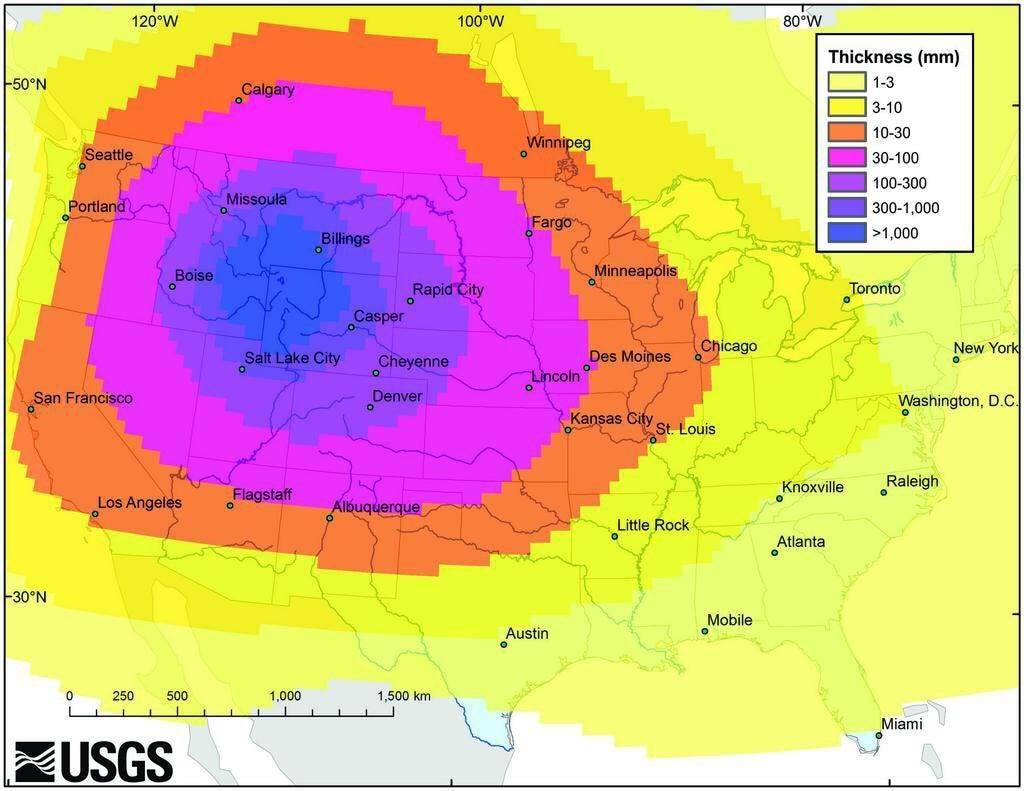BullKurtz
Gold Member
- Banned
- #1
When this baby BLOWS we in the western US are in for it....think A-bomb type of damage. 

A giant reservoir of magma and hot rock beneath the Yellowstone supervolcano has been found and imaged. The newly found reservoir lies 12-28 miles below the surface, and is four-and-a-half times larger than the shallower, hot melted rock zone that powers current Yellowstone geysers and caused the caldera's last eruption some 70,000 years ago.
The volume of the newly imaged, deeper reservoir is a whopping 11,000 cubic-miles (46,000 cubic kilometers), which is about the volume of Long Island with 9 miles of hot rock piled on it, or 300 Lake Tahoes. The discovery begins to fill in a gray area about how Yellowstone connects to a far deeper plume of heat rising up from the Earth's mantle.
“It's existence has been suspected for a while,” said University of Utah geophysicist Hsin-Hua Huang of the newly imaged hot reservoir. Huang is the lead author of a paper announcing the discovery in the Thursday issue of the journal ScienceExpress.
Peering Inside Yellowstone s Supervolcano Discovery News
Scientists with the United States Geological Survey, partly to establish “quantitative research in terms of regional ashfall impacts” in the event of a modern-day eruption, and partly, I’d like to imagine, to fuel all of our nightmares, set out to investigate just that. Their results, published in the journal Geochemistry, Geophysics, Geosystems, indicate that things would get really bad, really quickly.
To be clear, the researchers caution that it’s very unlikely this will happen any time soon. But if it did? Whoa.
For starters, there’s the ash: computer modeling indicates that a supereruption (as befits a supervolcano) would spew about 240 miles of it into the atmosphere, effectively shutting down electronic communications and air travel throughout the continent as it dispersed in what’s known as an “umbrella” cloud. How it lands depends on wind conditions, but cities closest to the eruption could end up blanketed in up to a meter of ash; those on the East, West and Gulf Coast would get smaller, but still disruptive, ash deposits of their own.

Even in places where the ash layer is only millimeters thick, water supplies and crops would be ruined; it would be hard to drive, and people would develop respiratory problems. And the climate itself would change significantly. While there are no historical examples large enough to draw a comparison, the researchers note that the considerably smaller Tambora eruption of 1815 ”cooled the planet enough to produce the famed ‘year without a summer’ in 1816, during which snow fell in June in eastern North America and crop failures led to the worst famine of the 19th century.” The reality, they add, pales in comparison to some of the theories floating around on the Internet; apparently that’s meant to be reassuring.
Here s how bad it would be if Yellowstone s supervolcano erupted today - Salon.com


A giant reservoir of magma and hot rock beneath the Yellowstone supervolcano has been found and imaged. The newly found reservoir lies 12-28 miles below the surface, and is four-and-a-half times larger than the shallower, hot melted rock zone that powers current Yellowstone geysers and caused the caldera's last eruption some 70,000 years ago.
The volume of the newly imaged, deeper reservoir is a whopping 11,000 cubic-miles (46,000 cubic kilometers), which is about the volume of Long Island with 9 miles of hot rock piled on it, or 300 Lake Tahoes. The discovery begins to fill in a gray area about how Yellowstone connects to a far deeper plume of heat rising up from the Earth's mantle.
“It's existence has been suspected for a while,” said University of Utah geophysicist Hsin-Hua Huang of the newly imaged hot reservoir. Huang is the lead author of a paper announcing the discovery in the Thursday issue of the journal ScienceExpress.
Peering Inside Yellowstone s Supervolcano Discovery News
Scientists with the United States Geological Survey, partly to establish “quantitative research in terms of regional ashfall impacts” in the event of a modern-day eruption, and partly, I’d like to imagine, to fuel all of our nightmares, set out to investigate just that. Their results, published in the journal Geochemistry, Geophysics, Geosystems, indicate that things would get really bad, really quickly.
To be clear, the researchers caution that it’s very unlikely this will happen any time soon. But if it did? Whoa.
For starters, there’s the ash: computer modeling indicates that a supereruption (as befits a supervolcano) would spew about 240 miles of it into the atmosphere, effectively shutting down electronic communications and air travel throughout the continent as it dispersed in what’s known as an “umbrella” cloud. How it lands depends on wind conditions, but cities closest to the eruption could end up blanketed in up to a meter of ash; those on the East, West and Gulf Coast would get smaller, but still disruptive, ash deposits of their own.

Even in places where the ash layer is only millimeters thick, water supplies and crops would be ruined; it would be hard to drive, and people would develop respiratory problems. And the climate itself would change significantly. While there are no historical examples large enough to draw a comparison, the researchers note that the considerably smaller Tambora eruption of 1815 ”cooled the planet enough to produce the famed ‘year without a summer’ in 1816, during which snow fell in June in eastern North America and crop failures led to the worst famine of the 19th century.” The reality, they add, pales in comparison to some of the theories floating around on the Internet; apparently that’s meant to be reassuring.
Here s how bad it would be if Yellowstone s supervolcano erupted today - Salon.com

